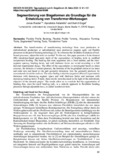Citation link:
http://dx.doi.org/10.25819/ubsi/10398Files in This Item:
| File | Description | Size | Format | |
|---|---|---|---|---|
| Reuter_Segmentierung_von_Biegeformen.pdf | 1.84 MB | Adobe PDF |  View/Open |
| Dokument Type: | InProceedings |
| metadata.dc.title: | Segmentierung von Biegeformen als Grundlage für die Entwicklung von Transformer-Werkzeugen |
| Authors: | Reuter, Jonas Aslanidis, Apostolos Engel, Bernd |
| Institute: | Institut für Produktionstechnik |
| Free keywords: | Flexible Profile Bending, Flexible Profile Forming, Adjustable Forming Tools, Segmented Forming Tools, Transformer Tools |
| Dewey Decimal Classification: | 620 Ingenieurwissenschaften und zugeordnete Tätigkeiten |
| GHBS-Clases: | ZIR |
| Issue Date: | 2023 |
| Publish Date: | 2023 |
| Source: | Engel, Bernd (Hrsg.): Transformation in der Biegetechnik : Tagungsband zum 6. Biegeforum Siegen : 24.-31. März 2023. Siegen: universi - Universitätsverlag Siegen, 2023. - ISBN 978-3-96182-155-6 - DOI http://dx.doi.org/10.25819/ubsi/10365, S. 91-101 |
| Abstract: | The transformation of manufacturing technology from mass production to individualized production or individualized mass production requires agile and flexible processes on the part of forming technology. To overcome the flexibility limitations of toolbound processes, adjustable tools are needed. To this end, this paper presents a finite element (FE) simulation-based parameter study of the segmenta... |
| DOI: | http://dx.doi.org/10.25819/ubsi/10398 |
| URN: | urn:nbn:de:hbz:467-26104 |
| URI: | https://dspace.ub.uni-siegen.de/handle/ubsi/2610 |
| License: |  Creative Commons BY-SA 4.0 Creative Commons BY-SA 4.0 |
| Appears in Collections: | Universi |
This item is protected by original copyright |


